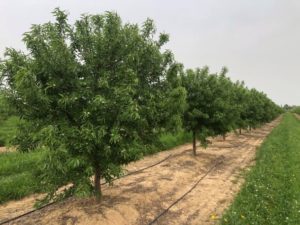2022 will be a difficult year. Increased input costs, including water, fuel, and fertilizer, and decrease crop pricing will impact the operational expenses and crop revenues significantly. Many operations will struggle to maintain cash flows through the year.
Operational costs should be closely evaluated to determine if savings are possible. Some expenses may be reduced on a short-term basis until pricing improves. Others may be eliminated from the current and future budgets due to more efficient management. A list of things to consider in helping reduce costs for the coming year include:
- Balance nitrogen rates. Typically, nitrogen budgets utilize a nitrogen use efficiency factor of 70%. By integrating more frequent, smaller applications of nitrogen, it is possible to assume a much higher utilization ratio – maybe closer to 85-90%. This could reduce nitrogen needs by 15-30 lbs/acre without impacting tree performance. Mid-summer leaf samples can provide feedback to this process (target range 2.2-2.5%).
- Test groundwater and accounting for nitrogen content. Groundwater in many parts of the San Joaquin Valley contains nitrate-nitrogen. If groundwater is used to irrigate orchard and it contains nitrate, make sure to account for the nitrogen and reduce the nitrogen budget.
- Balance potassium applications with any compost usage. The amounts of potassium and phosphorus within compost contribute to the nutrient budget of the orchard. Testing compost and accounting for moisture percentage should provide an estimate of the nutrients applied. This can reduce the need for fertilizers containing potassium and phosphorus (as well as many micronutrients).
- Review annual soil samples to determine if certain nutrients are not needed to be applied. It is common to see very high phosphorus amounts within CA soil samples and additional P may not be needed. Additionally, many loamy to clay containing soils contain potassium reserves. If the amount of potassium is high within the exchange complex, rates could be reduced for the year.
- Reduce single-product spray applications. By mixing multiple products to target multiple pests a spray pass can be reduced, saving time and money.
- Review pesticide recommendations to confirm that the products included are for the targeted pests and diseases. This includes thoughtful consideration of any additional products included in the mix. For example, are there cheaper surfactants or generic chemistries that can be used, are multiple foliar nutrients needed, and are the rates of chemical appropriate for control of the targeted pests and diseases?
- Foliar nutrients may not be needed every spray. Are deficiencies present and how are they being targeted? Is a foliar nutrient needed every foliar spray? Are cheaper products available (e.g. EDTA chelate vs amino acid chelate)? Many foliar nutrients are upsold to higher margin products when simpler formulations work as well.
- Additional spray additives such as blended nutrient products can be expensive and may not produce the desired benefit. Many of these tend to have variable results across orchards. Have they shown the ability to improve yields? Were these results from local trials? If so, how much – and will it be worth the treatment expenses? Are there any cheaper substitutes?
This list is not exhaustive and there are several other ways to reduce operational expenses. Improving efficiencies in irrigation management, harvesting operations, and other areas can lead to increased savings.

